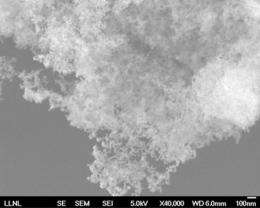May 10, 2011 report
U.S. team creates diamond aerogel in lab by emulating Mother Nature

(PhysOrg.com) -- Researchers working out of Lawrence Livermore and Lawrence Berkeley National Laboratories, have devised a process whereby an ordinary carbon aerogel is used as a base to create a new type aerogel comprised of diamond, making it not only denser, but translucent. In a paper published in the Proceedings of the National Academy of Sciences, (PNAS), the team describes a process where a carbon aerogel is set in a pool of neon gas, then subjected to pressure and then heat, causing diamond crystals to form, resulting in a diamond aerogel.
An aerogel is a highly porous material that is created by replacing the liquid in a gel substance, with gas, which results in a solid. In the new process, carbon aerogel is used to replicate the means by which diamonds are created in a natural environment. Here the carbon aerogel is placed in a diamond cell cavity where it is infused with neon gas (to keep the pores from collapsing). The whole works is then encased in a diamond shell and pressurized to 20GPa followed by a blasting from a laser that heats it to 1200K; once again to simulate the way that diamonds are formed naturally at great geological depths. The key to the process was keeping the pores from collapsing; neon gas was used because at pressures greater than 5GPa, it becomes a solid, thereby holding the walls of the pores in place as pressure and heat are added. The result is crystalline diamond with the lowest density ever created, (approximately 40 milligrams per cubic centimeter) according to team member, Peter Pauzauskie. He also said in a recent interview that diamond aerogel could likely be made that could be molded, like plastic to form whatever shape was desired.
Possible applications for the new material are diverse; ranging from flat panel television screens to highly efficient thermal window coatings, to possibly being used as a component in a quantum computer. It’s also possible they could make their way towards being used as part of medical implants due to diamonds being more highly biocompatible than other materials currently in use.
All of that will have to wait though, at least for a while, as the current technique was only able to produce diamond aerogel in sample sizes on the order of twice the size of a human hair’s thickness.
More information: Synthesis and characterization of a nanocrystalline diamond aerogel, PNAS, Published online before print May 9, 2011, doi: 10.1073/pnas.1010600108
Abstract
Aerogel materials have myriad scientific and technological applications due to their large intrinsic surface areas and ultralow densities. However, creating a nanodiamond aerogel matrix has remained an outstanding and intriguing challenge. Here we report the high-pressure, high-temperature synthesis of a diamond aerogel from an amorphous carbon aerogel precursor using a laser-heated diamond anvil cell. Neon is used as a chemically inert, near-hydrostatic pressure medium that prevents collapse of the aerogel under pressure by conformally filling the aerogel’s void volume. Electron and X-ray spectromicroscopy confirm the aerogel morphology and composition of the nanodiamond matrix. Time-resolved photoluminescence measurements of recovered material reveal the formation of both nitrogen- and silicon- vacancy point-defects, suggesting a broad range of applications for this nanocrystalline diamond aerogel.
© 2010 PhysOrg.com


















